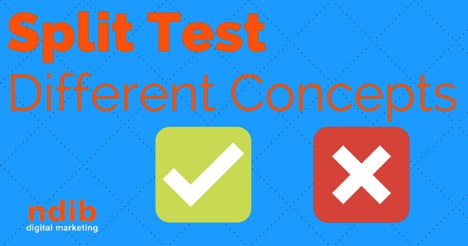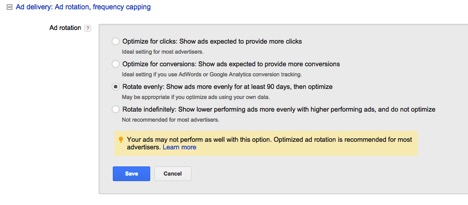
You just know as you write the ad that this split test will never complete.
But you write it anyway because for the past couple of weeks you have attempted to initiate a split testing practice for the text ads in your AdWords campaign. You can only say attempted a split testing practice rather than achieved a split testing practice because the results are grim. You write the ads, let them run and the results…always inconclusive.
At this point, you would even love for one of your experiments to lose to the control because at least then a test would complete and you would learn something.
It’s not for a lack of trying – you tried different variables such as a period vs. an exclamation point and changing how you describe a particular feature.
Problem: Your Variables Are The Same Concept
If you find that your split tests aren’t completing, it usually isn’t because you have the wrong setup or your process is off.
The problem is likely that you are testing variables that are too similar in concept.
It doesn’t mean that you are a bad marketer – this issue is a common mistake.
While it is possible to complete split tests by testing variables that are similar in concept, these types of split tests take a long time to complete and generally need a very high volume of clicks.
For example if you run the PPC program for a pizza place and split test the ad copy, “We deliver quickly” vs. “Speedy Delivery,” that particular split test could take an extremely long time. It may never complete because you are expressing the same concept in two different ways.
Another way to think about it is like this – if you were trying to find out your audience’s favorite band and the choices were NSYNC vs. Backstreet Boys, it would probably take a long time for one to emerge the winner because they are essentially expressing the same concept. However, if you were to ask the same question and the bands were NSYNC vs. Guns N’ Roses you would find that the test completes quickly because although they are both music, they are extremely different concepts of music.
Solution: Test Different Concepts
The solution to this problem is to test different concepts in your text ads so that the tests actually complete. This can include testing one benefit vs. a completely different benefit or one offer vs. a different offer and even one value proposition vs. another. You are not testing the wording of one concept twice and are instead asking users to instead choose between one concept or another.
For example, if you run a car dealership, instead of testing different wording for the same concept such as: “No Money Down” vs. “No Initial Payment,” test two completely different concepts such as: “No Money Down” vs. “Free Gas 1st Month.” While they are both offers, the concepts expressed within them are different. It will become apparent which concept drives the clicks.
When you split test different concepts you learn what your customers respond to, and have split tests that actually complete.
And yet – the click-through rate essentially remains the same between the ads day after day and week after week.
This is the frustrating experience of all too many PPC hero’s out there, who read the typical blogs and get stuck in split testing purgatory.
Fortunately, there is a solution. It’s not that hard and you can implement it immediately.
How to Split Test Different Concepts To Completion
Step One: Create A Hypothesis That Pits Two Concepts Against Each Other
Every split test should begin with a hypothesis. A good way to create a hypothesis is to use the phrase:
I am testing (control variable) vs. (test variable) because I believe my customers will respond to (test variable)
This way you are not just testing random variables, but rather creating a repeatable process that either validates or invalidates a theory and learns about your customers. As is the gist of this article, simply make sure that your two variables express a different concept.
Step Two: Let The Tests Run
Once you have your hypothesis, create two different ads to run against each other.
Be careful of the settings within AdWords that will ruin your split test. Make sure to set your ad rotation to either “Rotate evenly” or “Rotate indefinitely.”

You’ll then want to pick your network. Either just use the Search Network or only the Display Network. Users have different behaviors on the Search and Display Network and testing across networks will cloud your data.
Also, make sure to test mobile vs. mobile and desktop vs. desktop. The way users click and search can be dramatically different based on the device. You may find what works on mobile doesn’t work as well on desktop or vice versa.
Once all of your settings are correct, launch the test.
Step Three: Let Your Data Reach Statistical Significance, Review The Results, And Learn
You don’t want to just guess which ad performed better, you want to run a statistical analysis to be certain. There are a couple of different ways to accomplish this. My company uses AdAlysis, but there are plenty of other great tools out there.
Once you have the results and you can see if it either validates or invalidates your theory learn from them and apply to other marketing messages.
Step Four: Test Again
When you manage PPC you are never done testing. Once you have completed your split test, it is time to start a new one and continue learning about your customer base.
What variable have you seen the biggest lift by split testing?




